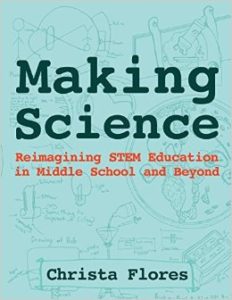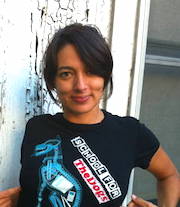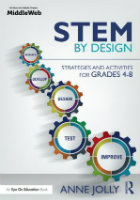A School Resource for STEM, Science & Making
A MiddleWeb Blog

But in teaching STEM, you will also often find yourselves designing and facilitating project and problem based learning (PBL). Like most STEM writers, I include PBL as I describe the STEM lesson process, but I realize that you may need to deepen your understanding of the all-important learning theory behind it. Why use a PBL approach?
Perhaps you’re also interested in the “making” movement and using making in your STEM lessons. How does making complement STEM? And exactly what is the educational value of making?
Making in the science classroom

Knowing why to use powerful inquiry-based practices contained in PBL and making can help you be more effective in the how of STEM lessons. Here are some of my favorite take-aways from the book.
► This book offers plenty of What and Why for all content areas. Suppose you want to know what invention looks like in the classroom (Christa tells us that it looks like playing, tinkering, brainstorming, hacking, reusing, up-cycling, creating, devising better solutions, and so on.) Or maybe you wonder what inquiry and modeling look like.
You’ll enjoy reading this material for your own sake, but here’s an exciting thought . . . This information could be used schoolwide to create a stimulating atmosphere of learning that supports STEM! In other words, Making Science is not just for science teachers. It’s a great read for all content area teachers who want to align their practices with STEM approaches.
► Making Science is packed with ideas for activities that build habits of mind and skills that focus kids on solving real world problems – the heart of STEM. Remember – those activities and ideas can apply across disciplines. Having said that, let me focus on the science content area for a moment.
As a retired science teacher, I really appreciate the jump Christa makes from traditional science teaching and scripted labs to a facilitated problem-solving approach. A constructivist PBL approach to science teaching is an important step into the STEM world.
(Note: Some folks treat science and STEM like synonyms but that’s not necessarily the case. For example, not all science lessons have the same dedicated focus as STEM lessons on solving a real problem. A science lesson doesn’t always have an engineering design and application. And not all science lessons intentionally integrate math objectives.)
► The book focuses strongly on ethics. Many believe that, as a society, we seem to be facing an increasing crisis in social conscience. True? I’m not sure. But I remember my foreboding when each year’s crop of students increasingly asked, “What does that have to do with me?” or responded “It’s not my fault” anytime a problem occurred. Then they began talking more to their technology devices than they did to real people. Go figure.
In this peculiar environment, science and STEM offer opportunities to activate thoughtful scrutiny and analysis among students. Teachers are the key in productively focusing students on moral responsibility and integrity; and Making Science treats ethics as an important STEM function.

In attempting to solve problems, they can begin to consider the ethical impacts of their solutions on the environment, society, and themselves. The STEM disciplines often offer students unique chances to see immediate, visible impacts of decision-making. They will impact their world, and it will impact them.
► Making Science treats assessment as a process of acquiring feedback for the purpose of ongoing learning. I especially like Christa’s presentation of assessment as a snapshot to determine the degree of student success midstream. More and more teachers today rightly regard “failure” as a marker along the road to success.

The assessment chapter also contains some updated ideas such as badges, resumes, content check-ins, product design reports, a variety of self-assessments, and “the Crit.” (The Crit is pretty cool – you’ll find out all about it in the assessment chapter.)
What resources would you recommend?
I’ve actually mentioned very little of what’s available in this book. It contains plenty of case studies that generate some new ideas for STEM projects, including a Problems unit based on meeting needs that students identify. Making Science also touches on equity, art, and surviving as a constructivist teacher.
I didn’t intend this to be an actual book review, but I found this resource valuable and wanted to give you a heads-up about it as well.
What books and related resources have helped you as a STEM teacher or STEM leader? Please mention them in the comments section; and I’ll check them out and let you know what I think as time permits.
In the meantime, Happy New Year and have a terrific 2017! Let me thank you for reading the STEM by Design blog and invite you to send me STEM topics you’d like me to investigate and write about for 2017. I would truly welcome knowing what about STEM interests you the most!
* Christa Flores (@sciteach212) is the Educational Outreach Manager for the Georgia Institute of Technology where she co-creates learning experiences in K-8 settings with teachers and administrators and researches the benefits of constructionism. In addition, she is a Senior FabLearn Fellow at Stanford University. Prior to five years as the Problem-Based Science Facilitator and Makerspace Coordinator at the Hillbrook School, Los Gatos, CA, Christa taught science in several schools to middle grades students for over a decade. She earned a BA in Biological Anthropology at UC San Diego, studied at Hunter College, and received a MA in Secondary Science Education from Teachers College of Columbia University.
Image/feature credit: Christa Flores
________________________































